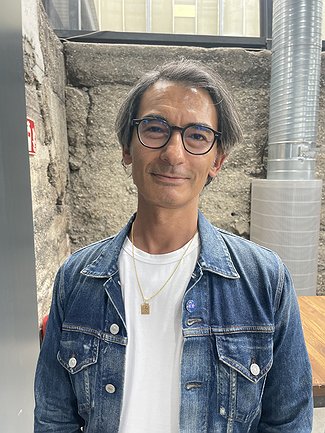INDUSTRY FOCUS: DENIM
Identifying Denim’s Most Important Challenges
Although blue bloods love their denim, this category has experienced a number of supply-chain challenges over the last four years, and, although some were briefly solved, it seems new issues replaced those that were fixed. The extensive number of global problems—war, costs, congested shipping routes—have made tackling any of the issues a daunting task. Some might even be concerned with the lack of humanity and understanding that is absent from some areas of the business. For the mission-driven company, one unexpected problem can disrupt the entire business and strain relationships with partners who provide specialized services.
Whether denim professionals are focused on creating greater eco initiatives, navigating transport delays, or managing and applying data resources, every denimhead is passionate about one issue as a priority over all other problems currently affecting the industry.
California Apparel News asked denim professionals: What denim supply-chain challenge is most pressing and preventing the industry from operating efficiently?
Wilson Avalos
Vice President of Apparel and Sourcing
The Common Link
Having access to documented and factually backed information about the supply chain is not easy and requires unrestricted commitment to communicate to all stakeholders about the origin, source and transformation of every component of the product through its journey across the entire value chain.
More importantly, making this data-driven information a subject of scrutiny requires a deep understanding of our role and responsibility about the decisions that we make for the betterment of our social and environmental impact.
Sanjeev Bahl
Chief Executive Officer
Saitex
The general lead time from concept to merchandise in store can be anywhere from eight to 10 months, highlighting the inefficiencies of the current supply chain. Additionally, the supply chain is hindered by excessive barriers. Information sharing is siloed and limited to a PLM that is very operational and transactional. The lack of transparency with sales data prevents the supply chain from being predictive and proactive regarding capacity and inventory.
Marco Bruno
Head of ESG Compliance & Health and Safety
Oerlikon Luxury
The whole supply chain is putting effort into offering solutions more and more aligned with sustainability criteria. Each company, in its own small ways, invests in research and development to wholly improve its direct market segment—from the designer imagining clothing items to the fabric and accessories suppliers to the professionals in charge of processing and finishing to those taking care of logistics. It’s up to brands to find the best and most functional way to foster connections between these players, integrating them into a final product that meets sustainability standards that take into account the origin of the materials and the impact of the processes as well as the possibility to reutilize the whole post-consumer garment or parts of it.
A more sustainable option in the process is using screw buttons that are easily removable and disposable; single-material denim buttons made of stainless steel—a material that is characterized by high recyclability and resistance to oxidation, resulting in a lower environmental impact of about 10 percent less than brass; and the use of brass and steel with a percentage of recycled material that amounts, respectively, to 80 and 50 percent.
Surface treatments also play a crucial role in the garment’s final sustainability balance. Oerlikon Riri is speeding up its transition toward new solutions, specifically through the use of the physical-vapor-deposition technique, a physical process that will significantly reduce the impact on the environment and that can also be applied to steel buttons.
Paola Corna
Co–Chief Executive Officer
ACM
The logistics of components and final products is something that is often underestimated by the majority of the industry insiders, who are usually mainly focused on sustainability and product research. As players in this field for over 40 years, we are very familiar with the clashes that occur between brands’ productive and logistical needs and external difficulties such as economic and geopolitical dynamics.
This is why we work with our partners across the globe to foster collaborations and commercial partnerships that will enable us to reach and assist them anywhere through our short and reliable supply chain. Those who turn to the ACM group know they can count on a partner who supplies buttons, leather goods and accessories on a global scale, striving to optimize the impact of its production on a daily basis and actively participating in the improvement of the fashion value chain.
Alberto de Conti
Head of Hub1922
Rudolf
Some of the most pressing challenges in the denim supply chain are surprisingly linked to sustainability issues that significantly affect the efficiency of the industry. Denim production is resource intensive, can consume large amounts of water and energy, and can lead to pollution through the improper use of dyes and chemicals. This environmental impact is exacerbated by the fragmented nature of the industry, which involves numerous players, often spread across different countries. The lack of transparency and traceability within this complex supply chain amplifies inefficiencies and makes it difficult to implement and monitor environmental improvements.
As consumers and regulators increasingly demand environmentally friendly products, denim companies are under pressure to adopt more-sustainable practices. However, these innovations often require significant investment and coordination across the supply chain, posing logistical and financial challenges. The industry’s reliance on traditional processes and resistance to change further hinder the widespread adoption of these sustainable solutions. Overcoming these challenges requires a concerted effort to improve transparency and standardize practices to enable a more resilient and efficient denim supply chain that meets both environmental and economic goals.
Anatt Finkler
Creative Director
Global Denim
I think the most pressing issue we are facing at the moment is the swift buying patterns from customers, minimum orders and time management. These changes have required a shift in how mills and manufacturers operate, posing ongoing challenges to maximize efficiency and cost-effectiveness under new brand requirements. Efficiency in production and scaling up quantities of a single product streamlines everything when executed perfectly. However, when minimum orders change and production methods must adapt, it becomes challenging and time consuming. Additionally, price volatility in raw materials, chemicals and operating costs has made it incredibly difficult for everyone in the supply chain. This volatility is a key factor that disrupts smooth operations, yet we’ve shown adaptability and resilience in overcoming these challenges as an industry.
Paolo Gnutti
Creative Director
ISKO Luxury by PG
In my opinion, verification and monitoring of production chains by brands remains a key to making our industry increasingly efficient. The lack of complete visibility into the various stages of the supply chain, from the origin of raw materials to the production of final products, makes it difficult if not impossible to ensure that the practices adopted are ethical and sustainable.
Communicating this information to the end user is another crucial challenge. Consumers are increasingly concerned about sustainability and the working conditions behind the products they buy but often lack access to detailed and reliable information. Brands must invest in transparent communication, using clear labels and third-party-verified sustainability reports to inform consumers about their practices along the supply chain.
Addressing these challenges requires a concerted effort by the entire apparel industry. It is essential to develop partnerships with suppliers of sustainable raw materials, implement advanced traceability technologies, and foster a culture of transparency and accountability. Only in this way can the industry operate more efficiently and sustainably, meeting the needs of an increasingly aware and informed market.
Adriano Goldschmied
Founder
Genious Group
There are so many areas in the supply chain that can be improved. If I have to choose one that is the most important I would say it is complete and efficient digitalization. This is a segment that can dramatically improve design, product development, production and quality control. Unfortunately, if one player within the chain is not responding, the entire project is not going to work, so teamwork is crucial.
Juan Carlos Gordillo
Denim Designer
One of the most pressing challenges in the denim supply chain is sustainability and material traceability, compounded by the global fragmentation of production. For instance, cotton might be sourced from Latin America, buttons from Turkey and thread from another region. This geographical dispersion complicates efficient and responsible supply-chain management.
In 2024 supply chains are undergoing transformative changes driven by advanced technologies, sustainability, artificial intelligence, digitalization, cybersecurity and labor shortages. While these trends promise greater efficiency, they also introduce critical challenges that demand immediate attention.
Fragmentation impacts efficiency by increasing costs and production times and complicating compliance with environmental and labor regulations. Insufficient traceability can undermine consumer trust and expose companies to reputational risks and potential penalties.
To enhance efficiency and address these challenges, prioritizing more-localized production is crucial. Ensuring all stages of the supply chain operate in regions with clear and honest human rights and environmental standards can significantly improve management.
Additionally, leveraging advanced technologies like AI, big-data analytics and blockchain along with stringent certification standards can ensure transparency and sustainability throughout the entire supply chain. This approach not only enhances operational efficiency but also strengthens consumer trust and corporate responsibility.
By fostering a culture of innovation and continuous improvement and investing in both cutting-edge systems and talent development, companies can navigate the complexities of the modern supply chain. This holistic strategy is essential for building a resilient, efficient and sustainable denim supply chain that meets the demands of today’s global market.
Simon Hong
Denim Lead
Hyosung
One of the most pressing challenges in the denim supply chain is environmental sustainability and transparency. From the perspective of a spandex manufacturer, these issues directly impact product performance, quality and the company’s reputation.
Achieving transparency in the spandex supply chain is essential. It is necessary to track and verify every stage from raw-material sourcing to the final product. This is crucial for addressing environmental issues and for achieving the company’s sustainability goals.
Spandex manufacturers need to integrate the latest technologies to enhance sustainability. Adopting planet-friendly raw materials and recycling processes requires substantial investment and technological effort; however, these initiatives help reduce environmental impact and enhance the company’s competitiveness in the long run. Addressing these challenges requires collaboration between spandex manufacturers and the broader denim industry. Stronger regulations, increased transparency, investment in sustainable technologies and a commitment to ethical practices are essential.
Tuncay Kılıçkan
Head of Global Business Development for Denim
Lenzing
My response would definitely be visibility. Especially since COVID, the industry had strong headwinds—like all of a sudden the orders are canceled or there is a huge demand, which cannot be responded to in such a short period of time.
The industry just experienced this at the beginning of 2024. Due to the Red Sea crisis, the transportation from Asia became an immediate topic, and there have been overbookings as the supply chain and the lead times are shortened sharply with freight costs accordingly affected. This situation of course challenges the raw-material prices as well. When it comes to reflecting these unprecedented costs to the final product costs, the supply chain faces serious issues. Often those costs are absorbed by the supply chain, which disturbs the profitability of the companies.
On the other side, the brands may have inventory issues, which was also experienced in the second half of 2022 and in the entirety of 2023. Loss of liquidity and margin is one of those negative results of this problem. Besides, those negative experiences disrupt the purchasing practices of the brands. The decision-makers wait until the last moment and then confirm orders, which eventually puts great pressure on the supply chain and reduces efficiency.
Rebecca Larsen
Senior Manager of Business Development
AGI Denim
Currently the denim industry’s supply chain is fast paced and unpredictable. Reduced inventory levels, increased sales and a sudden boom in demand have made it crucial for both brands and vendors to remain agile and closely connected for up-to-date forecasts and production planning.
In 2023, many retailers and our brand partners faced excess-inventory issues. As consumer demand rises, the need for quick responses, chase orders and fresh products becomes more pressing. Speed in development and design support is now essential. We are seeing a growing reliance on vendors to provide additional support and capabilities to help brand partners meet the fast-paced demand for trends and newness.
AGI Denim’s The Agency offers a collaborative partnership between our in-house team of creatives and our brand counterparts. By leveraging our verticality, we provide accelerated support and services, enabling brands to capture consumer needs more efficiently. In the near future, we hope to utilize digital design by providing solutions for rapid prototyping in digital 3D designs and AI-generated visuals as well as physical formats on a larger scale.
It is crucial for vendors and brands to work together and maintain healthy, strategic partnerships to ensure sustainable, long-term growth in the ever-changing denim-supply-chain environment.
Amy Leverton
Founder
Denim Dudes
Something that comes up often when we talk to clients about working with the supply chain is the overwhelming number of vendors out there and the task of finding the right fit for their needs. From fledgling labels to big-box brands, finding the right partners takes up so much energy.
Our Denim Directory aims to help designers at the brand level by showcasing the larger global mills’ and manufacturers’ latest developments and providing a directory of contacts, but just last night I was talking to a friend in from L.A. who’s trying to find a new local wash house and for her MOQs and needs it’s proving to be so fruitless and frustrating. The supply chain needs clients and the brands need supply chains, yet there’s still no easy way to efficiently match the two.
Marco Lucietti
Head of Global Marketing and Communications
RE&UP
The industry faces many challenges, but we are particularly passionate about tackling one of the biggest: managing textile waste. A report from the Global Fashion Agenda and BCG highlights that, by 2030, 148 million tonnes of textile waste will end up in landfills. This staggering figure underscores the urgent need for better infrastructure to scale effective waste management. Textile recycling is crucial, and the future of a streamlined and efficient supply chain depends on our ability to not only recycle both mono and blended textiles but to also offer back to the industry high-quality, performance-driven “next-gen” fibers that rival conventional virgin fibers in quality and cost.
At RE&UP, we’re not just envisioning this future—we’re actively creating it. We’re already processing 80,000 tonnes annually and have ambitious plans to scale up to 1 million tonnes by 2030, focusing on the most prevalent of textile-waste compositions: cotton, polyester and cotton-poly blends. Our collaborative efforts with brands, municipalities, NGOs and other industry partners are making this vision a reality.
Philippe Mignot
Project Manager
NextPrinting
The world of denim is one of the most interesting segments on the fashion scene, having played in recent years and continuing to perform a pivotal role in optimizing consumption and reducing the impact of the typical treatments and finishing processes. The challenge is undoubtedly hard, and there is still a long road ahead, but solutions do exist and can be implemented, and a great example of this is NextPrinting digital print on fabric.
NextPrinting has developed a printing system that reproduces extremely realistic and repeatable effects on garments with a true-to-life visual impact, drastically reducing the consumption of energy, water and chemicals from the fabric’s manufacturing to the garment’s.
Sebla Önder
Marketing and Sustainability Manager
ORTA
Denim has a complex and always-changing supply chain that gets affected by local and global uncertainties. This prevents the industry from operating efficiently. As a player in the supply chain, we need to manage all details in different parts of the world, meaning in different economic and political environments.
Cotton farmers, fiber producers, vendors, mills and all other suppliers that are involved through this process face the same challenges as well. Therefore, at ORTA, we position ourselves to become more flexible and resilient to all by focusing on value-added, good-quality products and services instead of big production numbers.
Ebru Ozaydin
Global Strategic Marketing Director
Denim, Wovens, Ready-to-Wear
The LYCRA Company
Global denim manufacturing is transforming based on various dynamics. There are plenty of challenges in our industry, from economic pressures to talent deficit, including:
• Change in the denim supply-chain map: Started as of 2020, the map for manufacturing changed and recently expanded into new territories both in the Western and Eastern hemispheres such as Egypt, Vietnam and Mexico. We’re seeing capacity increase in certain regions, but some still suffer from lack of innovation or time-to-market. Verticality plays an important role due to price pressure, lead times, flexibility and prompt response to market changes.
• Supply and demand imbalance: Consumers are still on tight budgets, heavily affected by the cost of living. The lack of clarity as well as the disappearance of macro trends leads the supply chain to have difficulty focusing on the right product. Therefore, even if makers are excited about novelty products and technologies, brands go slow. Furthermore, it creates a fierce competition among industry players as supply seems more than demand at the moment.
• New legislations: Brands and retailers are looking for the suppliers who offer innovative products and technologies made sustainably, from farm to fashion. Regulatory actions and new legislations on the table are adding more pressure in manufacturing since it needs smart investment plans and hiring new talent.
• Talent deficit: We’ve been losing a denim generation of well-educated, high-expertise professionals [to those] who unfortunately do not have the same level of understanding of denim across the value chain. That’s at all levels, from on-site blue-collars to denim experts.
Jose Royo
President
Tejidos Royo
Buying from the USA, producing in the Far East, Egypt or South America, has a lot of inefficiencies. Buying from Pakistan, producing in China or Cambodia, and then sending the garments by boat to the USA has a huge CO2 footprint. Maybe the garment is mega sustainable, but we are killing all the advantages in the transport.
Textile companies focus on fabric and garment sustainability, but nobody is paying attention to transport companies. Do they have new boats producing less CO2? Are the trucks that go from one factory to another sustainable? We don’t pay enough attention to these matters.
The supply chain is key for reaching the [UN’s] 2030 [sustainability] agenda, and we are not looking into it deeply.
Regarding transport time, the Red Sea situation is creating a time problem. Now we need to go around Africa, which means 15 to 20 days more transit time. It is more expensive and a time disadvantage for European mills. Some of our customers have decided to send goods by air.
Time is money, but on the other hand it makes my fabrics less appealing for the customers as it is not at the confirmed and calculated price. Air costs are going up since there is more demand. Money for the transport companies means less for the manufacturers. Our business is fabrics and garments, not transport. It’s a cost that we are adding to the garment and needs to be taken from somewhere, usually from the margin of the fabric suppliers.
Kutay Saritosun
Director of Brand Services and Partnerships
bluesign
The most pressing challenge in the denim supply chain is the widespread use of hazardous chemicals and unsustainable practices, which compromise environmental safety, worker health and ultimately the efficiency of the industry. These practices not only threaten ecosystems and communities but also result in inefficiencies due to regulatory compliance issues, increased waste and resource overuse.
Our solution, the bluesign Denim initiative, focuses on Input Stream Management, which ensures that only safe, approved chemical products are being used from the beginning of fabric production as well as in the laundry processes. bluesign Denim is not only about the chemistry that is being used but also, from fabric to fashion, that all production processes leading up to the end product comply with the strict bluesign Denim criteria. This comprehensive approach mitigates risks for the workers, the environment and ultimately leads to safer denim products for the consumers.
In summary, the key to overcoming the most pressing denim-supply-chain challenge lies in embracing sustainable practices and rigorous standards like those provided by bluesign. This not only ensures a safer and cleaner production process but also enhances overall denim-industry sustainability.
Carolina Sister Cohn
Global Marketing Leader for Textiles
Eastman
The most pressing challenge in the denim supply chain today revolves around reconciling the classic performance and iconic style of denim with the urgent need for sustainability.
Manufacturers face the dilemma of integrating sustainable materials that are both scalable and effective without sacrificing the quality, fashion or comfort that consumers expect from their denim products. To address this, there’s a significant shift toward using sustainable fibers like Naia Renew, which has a strong and transparent sustainability story that brands can pass on to their customers and denim lovers all over the world, making them more aware of their choices.
Naia Renew is a cellulosic acetate fiber made from 60 percent sustainably sourced wood pulp and 40 percent GRS-certified recycled content, which is diverted from landfills and broken down to its molecular building blocks via Eastman’s patented molecular-recycling technology.
Suzanne Shpall
Brand Director
Edwin USA
The traditional wholesale model is the biggest challenge. In an increasingly omni-channel, nimble and digitally optimized world, the modus operandi of the traditional wholesale model can feel sluggish, creatively stifling and wasteful.
Amanda Starling
Executive Director, Industry Relations and Career Center Special Projects Chair
The Business of Denim Chair
International Manufacturing and Product Development Chair
Fashion Institute of Design & Merchandising
Disrupters remain the biggest challenge facing the denim industry. Impacts from these disruptions, whether a natural disaster, increase in cost, scarcity of raw materials, political unrest, economic instability, radical change in technology, artificial intelligence or innovation in the market impact the consumer and the supply chain, which requires constant flexibility.
Brands are being challenged to anticipate, adapt, be transparent, balance cost and remain resilient all at the same time. Since efficiency measures differently within every brand, company and country, any, all or a combination of these interruptions requires a relentless battle to keep up.
While the consumer may or may not be aware of these constant changes, their demands can be indecisive based on individual beliefs. However, it is vital for brands to anticipate consumer needs through sustainability, innovation, cost-sensitive product, creative designs and overall lifestyle experiences.
Whereas these challenges within today’s circular economy require transformation, consumer education and transparency, the idea of risk management takes on an entirely new business focus. These distractions must be assessed by balancing cost and being resilient with an adaptable contingency plan that must be reviewed and revised constantly. With the added future of artificial intelligence both the consumer and the supply chain will continue to keep the industry in a state of change while we meet the requirements of a connected economy.
Katie Tague
Vice President Denim Marketing and Sales
Artistic Milliners PVT LTD
The biggest denim-supply-chain challenge these days? It’s the lack of vertical integration and localized sourcing. This fragmentation causes inefficiencies, longer lead times and a bigger carbon footprint due to transporting goods over long distances.
Artistic Milliners and Star Fades International have tackled these challenges through vertical integration by managing spinning to garment manufacturing in-house. This streamlined process cuts down on lead times, keeping us agile and responsive to market trends.
Localized sourcing in key regions like Pakistan, Bangladesh, Mexico and Los Angeles brings manufacturing closer to consumers. This slashes transportation distances, reduces our carbon footprint and creates local jobs.
We use innovations in sustainable materials, water-saving tech and circular practices that drive efficiency and sustainability throughout the supply chain. We’re always looking for new ways to minimize waste and conserve resources.
Relying on efficient, localized production hubs means we can get products to market faster—essential in the ever-changing fashion world.
Helping brands and retailers navigate the denim supply chain ensures their decisions align with sustainability goals. We are able to lead all tiers of brands and their teams through the production process, from concept to their collections.
We’re committed to leading positive change and collaborating with stakeholders to promote transparency, sustainability and ethical practices.
Adam Taubenfligel
Creative Director
Triarchy
The industry’s relentless drive to cut costs is hindering its overall efficiency. When brands focus solely on reducing prices, they often resort to unsustainable practices, undermining the industry’s effectiveness by diverting attention from long-term priorities.
To genuinely promote sustainability, we must prioritize technologies and practices that enable true sustainability rather than treating the term as a marketing gimmick. By doing so we can collectively reduce the costs associated with sustainable practices, effect real change within the industry and ultimately enhance its efficiency.
Alice Tonello
Marketing, Research and Development
Tonello
The primary challenge preventing the industry from operating efficiently is the lack of universal standards for transparency. Without clear data on water, energy, chemicals and CO2 consumption, brands struggle to make informed decisions and implement effective practices.
Engaging consumers in conscious purchasing is equally important. Brands should educate their customers about the benefits of denim produced responsibly and ethically. By emphasizing the long-term value and durability of high-quality products, consumers can make better choices.
Additionally, providing information about the recyclability of garments is crucial. This includes details on whether a garment can be recycled and how the process works. Educating consumers in this way helps to reduce waste, overproduction and overconsumption, contributing to a more responsible industry.
Andrea Venier
Managing Director
Officina39
One of the most pressing challenges in the denim supply chain is the development and implementation of effective circular-economy infrastructures. In Europe, the classification and management of recycled materials poses significant regulatory hurdles as these materials often originate from what is considered waste. This classification introduces complexities in waste management, hindering the smooth transition to using these materials as recycled raw resources.
Circularity in the denim industry extends beyond consumer interest or demand. While consumer preferences can drive brands toward more-sustainable practices, including the use of recycled materials, the responsibility does not rest solely with them. It is imperative that companies, governments and related organizations make substantial efforts to establish systems and structures that promote recycling behaviors and the utilization of recycled and upcycled products. Moreover, building trust is crucial for the circular economy to thrive.
Companies must commit to transparency and genuine engagement—principles we at Officina39 embody through our concept of “Trustainable.” For the circular economy to become a tangible reality, it requires a collaborative approach where information is openly shared and all stakeholders are actively involved in fostering a sustainable and efficient supply chain.
Luciano Vivolo
Founder and President
Vivolo
One of the most interesting challenges in the current fashion scene is to make design priorities coexist with eco-sustainable requirements. This is especially true in a segment like denim, with strong traditions and an unmistakable iconographic language. Many brands are investing in innovative materials and processes to make garments more environmentally responsible—however, the making of a fully sustainable garment requires a careful analysis of every stage of production, from the origin of the materials to the product’s end of life.
Vivolo has been meeting this need for truly sustainable materials for years with its Impronta Zero program and collections that get renewed for each season, offering recycled or recyclable, natural or biodegradable, items. Only those who have integrated sustainability among their values can truly focus on what fashion will always need, which is beauty. This is why a fundamental key factor is specific training for designers, who play a central role in design choices and consequently have a significant impact that ripples throughout the supply chain.
Vivolo, in collaboration with the Academy of Fine Arts in Bologna, Italy, holds a yearly competition to reward the most innovative design students and offers them in-company training courses. Designers trained in sustainability are able to make conscious choices that positively influence the product life cycle.
For this reason, it is necessary to be able to choose reliable and certified suppliers at every level—and as local as possible—in order to guarantee high standards, safety and sustainability along every single component’s path.
Vivian Wang
Managing Director and Global Sales Manager
Kingpins Show
I’ve gotten quite a lot of feedback from our exhibitors and attendees at our first three trade shows held so far this year, in New York, Amsterdam and Hangzhou, China.
They tell us that sustainability and transparency remain a top priority for many retailers and brands. But cost continues to be the key driver for their sourcing decisions. Our exhibitors are constantly pushing innovation—and Kingpins is committed to highlighting and sharing the news about these developments. But price pressure keeps their customers from implementing many of them.
This is particularly challenging right now because many companies are working toward the 2030 deadline for the United Nations Sustainable Development Goals. Plus, the European Union and the United Kingdom both have proposed new legislation aimed at combating greenwashing, so everyone is feeling the pressure to create sustainable products backed by reliable information that can be shared with their supply-chain partners.
We believe that this is an education issue that Kingpins is well positioned to address. We want to use our platform to reach denim’s next generation, to educate them about the latest fibers, fabrics and finishes. We want them to understand and appreciate these developments and recognize the value these innovations bring to their businesses.
Similarly, we want to share this information with end consumers, who haven’t been given enough insight into the work and technical expertise that goes into the products they buy. Our Kingpins China show blended B2B and B2C activities that highlighted many of our exhibitors’ latest innovations.
Ani Wells
Founder and Director
Simply Suzette
The biggest challenge in the denim supply chain isn’t about technology or processes—it’s the whole system that’s preventing us from operating efficiently. Purchasing a larger quantity and then selling half of it at a discounted price can sometimes be more cost effective than buying only the amount you need. We’re stuck in a cycle of overproduction and transactional relationships, which drains the soul out of the supply chain. This relentless push for more, faster and cheaper fuels inefficiencies and environmental stress, creating a cycle that is difficult to break.
The real issue is bringing humanity back into the supply chain. If we focused more on building relationships rather than purely making transactions, I believe we could naturally solve a lot of inefficiencies. Trust and collaboration would help us address problems together, share new ideas, and make decisions that balance the risks and rewards.
If suppliers and brands communicate openly and work toward mutual success, the potential to better align production with actual demand, reducing waste and boosting efficiency, would be great. Plus, a people-first approach encourages empathy, which is essential for sustainability and ethical labor practices.
Amy Williams
CEO
Citizens of Humanity Group
The industry’s slow adoption of regenerative cotton as a standard. This shift is crucial because it would allow mills to establish long-term relationships with regenerative farmers, enabling large-scale purchases and more-efficient textile development. Integrating regenerative cotton with recycled materials could significantly benefit the environment, enhance the livelihoods of farmers and positively impact their communities.
Responses have been edited for clarity and space.




















































